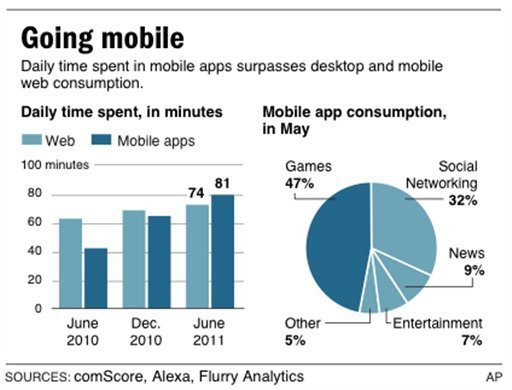Our thoughts: Mobile use and its potential impact on learning
September 21, 2011
A recent report of the Pew Internet and American Life Project suggests that Internet users will increasingly rely on mobile devices:
"Six in ten American adults are now wireless Internet users, and mobile data applications have grown more popular over the last year. [...] Taken together, 59% of American adults now go online wirelessly using either a laptop or cell phone, an increase over the 51% of Americans who did so at a similar point in 2009. [...] Nine in ten 18-29 year olds own a cell phone [...] More than half of mobile web users go online from their phones on a daily basis [...] Devices other than laptop computers and mobile phones also play into the wireless Internet story, as 9% of American adults now go online using an mp3 player, e-book reader or tablet computer. However, these devices largely play a supporting role for Americans who already access the Internet wirelessly using a laptop computer or cell phone. [...] This year for the first time we asked our respondents whether they owned a tablet PC such as an iPad, and 3% said that they do. Roughly six in ten of these individuals use their device to access the Internet." [Mobile Access 2010, Pew Internet and American Life Project Reports, 2010.]

Consumer engagement with these devices is significant and can border on obsessive when it interferes with daily activities, including sleep. In addition, as shown above, the time spent using mobile apps has surpassed time spent on the web.
"...consumers' dependence on mobile phones is only expected to grow as people use their phones for things like shopping and banking. Mobile commerce - purchases made when shoppers access stores' websites or mobile applications through their phones - is expected to account for $6 billion in sales this year, according to Forrester Research." [Sleep with your phone? You are not alone, Ellen Gibson, 2011.]
In his State of the Union 2011 remarks, President Obama also embraced these emerging technologies. He said,
“Within the next five years, we will make it possible for business to deploy the next generation of high-speed wireless coverage to 98% of all Americans. This isn't just about a faster internet and fewer dropped calls. It's about connecting every part of America to the digital age. It's about a rural community in Iowa or Alabama where farmers and small business owners will be able to sell their products all over the world. It's about a firefighter who can download the design of a burning building onto a handheld device; a student who can take classes with a digital textbook;…” [State of the Union 2011: Winning the Future, B. Obama, 2011.]
We believe that these trends in mobile device (especially tablet-based mobile devices) use will shape the delivery of texts and the experience of textual study in higher education. Academic and textbook publishers have quite reasonably been reluctant to embrace a mobile digital model, and existing mobile “reader” applications are designed mainly for trade fiction and nonfiction markets, not for the kind of in-depth study required in a college classroom. Current models also tend to replicate an ordinary reading experience, ignoring the potential of mobile platforms to add to that experience, not just multimedia (as the web has always offered) but an intuitive interface and the possibility of creating a improved medium that supports deep learning.
Given these trends, it is logical to expect educators to begin to embrace these mobile technologies in support of student learning. Engaging students in learning is critical to achieving education goals. By embracing students’ love of these devices and drawing on their extensive use of these devices for more than game and social networking applications, we believe we can exploit the satisfying human-computer interaction that a mobile device provides to motivate learning.